Co-Teaching: Difference between revisions
| Line 41: | Line 41: | ||
==Dataset Corruption== | ==Dataset Corruption== | ||
To simulate learning with noisy labels, the datasets (which are clean by default) are manually corrupted by applying a noise transformation matrix. Two methods are used for generating such noise transformation matrices: pair flipping and symmetry. | To simulate learning with noisy labels, the datasets (which are clean by default) are manually corrupted by applying a noise transformation matrix. Two methods are used for generating such noise transformation matrices: pair flipping and symmetry. | ||
[[File:Co-Teaching Fig 2.png|600px|center]] | [[File:Co-Teaching Fig 2.png|600px|center]] | ||
Three noise conditions are simulated for comparing co-teaching with baseline methods. | Three noise conditions are simulated for comparing co-teaching with baseline methods. | ||
Note: Corruption of Dataset here means randomly choosing a wrong label instead of the target label by applying noise. | |||
{| class="wikitable" | {| class="wikitable" | ||
{| border="1" cellpadding="3" | {| border="1" cellpadding="3" | ||
Revision as of 11:38, 8 November 2018
Introduction
Title of Paper
Co-teaching: Robust Training Deep Neural Networks with Extremely Noisy Labels
Contributions
The paper proposes a novel approach to training deep neural networks on data with noisy labels. The proposed architecture, named ‘co-teaching’, maintains two networks simultaneously, which focuses on training on selected clean instances and avoids to estimate the noise transition matrix. In addition, using stochastic optimization with momentum to train the deep networks and clean data can be memorized by nonlinear deep networks, which becomes robust. The experiments are conducted on noisy versions of MNIST, CIFAR-10 and CIFAR-100 datasets. Empirical results demonstrate that, under extremely noisy circumstances (i.e., 45% of noisy labels), the robustness of deep learning models trained by the Co-teaching approach is much superior to state-of-the-art baselines
Terminology
Ground-Truth Labels: The proper objective labels (i.e. the real, or ‘true’, labels) of the data.
Noisy Labels: Labels that are corrupted (either manually or through the data collection process) from ground-truth labels. This can result in false positives.
Intuition
The Co-teaching architecture maintains two networks with different learning abilities simultaneously. The reason why Co-teaching is more robust can be explained as follows. Usually when learning on a batch of noisy data, only the error from the network itself is transferred back to facilitate learning. But in the case of Co-teaching, the two networks are able to filter different type of errors, and flow back to itself and the other network. As a result, the two models learn together, from the network itself and the partner network.
Motivation
The paper draws motivation from two key facts:
• That many data collection processes yield noisy labels.
• That deep neural networks have a high capacity to overfit to noisy labels.
Because of these facts, it is challenging to train deep networks to be robust with noisy labels.
Related Works
1. Statistical learning methods: Some approaches use statistical learning methods for the problem of learning from extremely noisy labels. These approaches can be divided into 3 strands: surrogate loss, noise estimation, and probabilistic modeling. In the surrogate loss category, one work proposes an unbiased estimator to provide the noise corrected loss approach. Another work presented a robust non-convex loss, which is the special case in a family of robust losses. In the noise rate estimation category, some authors propose a class-probability estimator using order statistics on the range of scores. Another work presented the same estimator using the slope of ROC curve. In the probabilistic modeling category, there is a two coin model proposed to handle noise labels from multiple annotators.
2. Deep learning methods: There are also deep learning approaches that can be used to approach data with noisy labels. One work proposed a unified framework to distill knowledge from clean labels and knowledge graphs. Another work trained a label cleaning network by a small set of clean labels and used it to reduce the noise in large-scale noisy labels. There is also a proposed joint optimization framework to learn parameters and estimate true labels simultaneously. Another work leverages an additional validation set to adaptively assign weights to training examples in every iteration. One particular paper ads a crowd layer after the output layer for noisy labels from multiple annotators.
3. Learning to teach methods: It is another approach to this problem. The methods are made up by the teacher and student networks. The teacher network selects more informative instances for better training of student networks. Most works did not account for noisy labels, with exception to MentorNet, which applied the idea on data with noisy labels.
Co-Teaching Algorithm
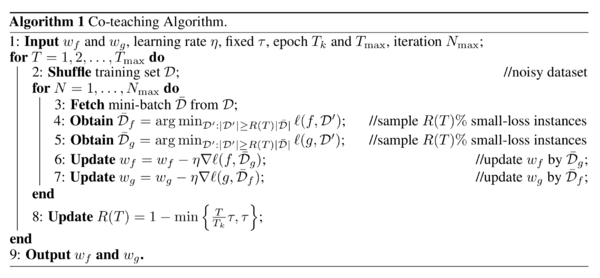
The idea as shown in the algorithm above is to train two deep networks simultaneously. In each mini-batch using mini-batch gradient descent, each network selects its small-loss instances as useful knowledge and then teaches these useful instances to the peer network. [math]\displaystyle{ R(T) }[/math] governs the percentage of small-loss instances to be used in updating the parameters of each network.
Summary of Experiment
Proposed Method
The proposed co-teaching method maintains two networks simultaneously, and samples instances with small loss at each mini batch. The sample of small-loss instances is then taught to the peer network.
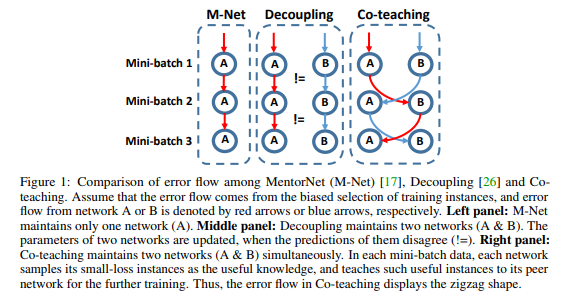
The co-teaching method relies on research that suggests deep networks learn clean and easy patterns in initial epochs, but are susceptible to overfitting noisy labels as the number of epochs grows. To counteract this, the co-teaching method reduces the mini-batch size by gradually increasing a drop rate (i.e., noisy instances with higher loss will be dropped at an increasing rate). The mini-batches are swapped between peer networks due to the underlying intuition that different classifiers will generate different decision boundaries. Swapping the mini-batches constitutes a sort of ‘peer-reviewing’ that promotes noise reduction since the error from a network is not directly transferred back to itself.
Dataset Corruption
To simulate learning with noisy labels, the datasets (which are clean by default) are manually corrupted by applying a noise transformation matrix. Two methods are used for generating such noise transformation matrices: pair flipping and symmetry.

Three noise conditions are simulated for comparing co-teaching with baseline methods.
Note: Corruption of Dataset here means randomly choosing a wrong label instead of the target label by applying noise.
| Method | Noise Rate | Rationale |
| Pair Flipping | 45% | Almost half of the instances have noisy labels. Simulates erroneous labels which are similar to true labels. |
| Symmetry | 50% | Half of the instances have noisy labels. Labels have a constant probability of being corrupted. Further rationale can be found at [1]. |
| Symmetry | 20% | Verify the robustness of co-teaching in a low-level noise scenario. |
Baseline Comparisons
The co-teaching method is compared with several baseline approaches, which have varying:
• proficiency in dealing with a large number of classes,
• ability to resist heavy noise,
• need to combine with specific network architectures, and
• need to be pretrained.

Bootstrap
A method that deems a weighted combination of predicted and original labels as correct, and then solves kernels by backpropagation [2].
S-Model
Using an additional softmax layer to model the noise transition matrix [3].
F-Correction
Correcting the prediction by using a noise transition matrix which is estimated by a standard network [4].
Decoupling
Two separate classifiers are used in this technique. Parameters are updated using only the samples that are classified differently between the two models [5].
MentorNet
A mentor network is weights the probability of data instances being clean/noisy in order to train the student network on cleaner instances [6].
Implementation Details
Two CNN models using the same architecture (shown below) are used as the peer networks for the co-teaching method. They are initialized with different parameters in order to be significantly different from one another (different initial parameters can lead to different local minima). An Adam optimizer (momentum=0.9), a learning rate of 0.001, a batch size of 128, and 200 epochs are used for each dataset. The networks also utilize dropout and batch normalization.
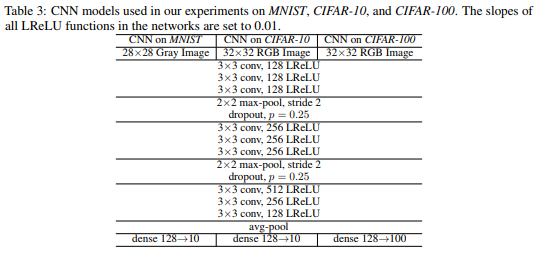
Results and Discussion
The co-teaching algorithm is compared to the baseline approaches under the noise conditions previously described. The results are as follows.
MNIST
The results of testing on the MNIST dataset are shown below. The Symmetry-20% case can be taken as a near-baseline; all methods perform well. However, under the Symmetry-50% case, all methods except MentorNet and Co-Teaching drop below 90% accuracy. Under the Pair-45% case, all methods except MentorNet and Co-Teaching drop below 60%. Under both high-noise conditions, the Co-Teaching method produces the highest accuracy. Similar patterns can be seen in the two additional sets of test results, though the specific accuracy values are different. Co-Teaching performs best under the high-noise situations
The images labelled 'Figure 3' show test accuracy with respect to epoch of the various algorithms. Many algorithms show evidence of over-fitting or being influenced by noisy data, after reaching initial high accuracy. MentorNet and Co-Teaching experience this less than other methods, and Co-Teaching generally achieves higher accuracy than MentorNet.

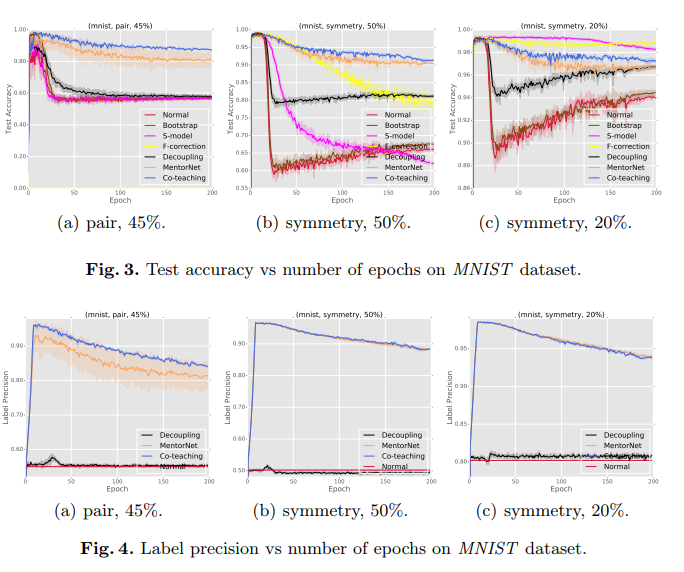
CIFAR10

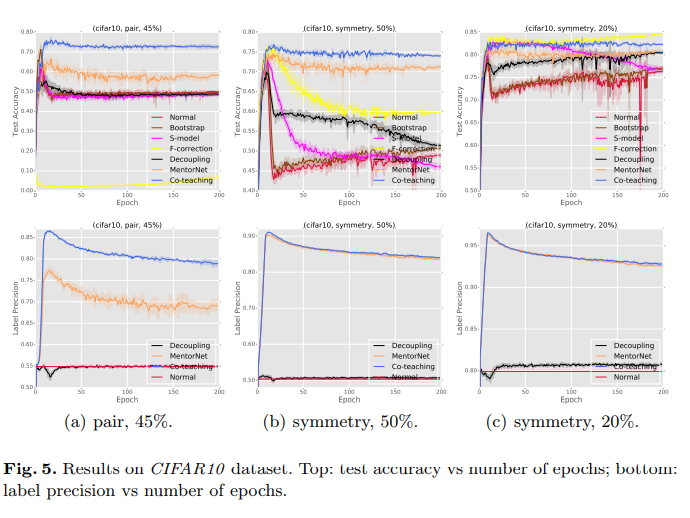
CIFAR100

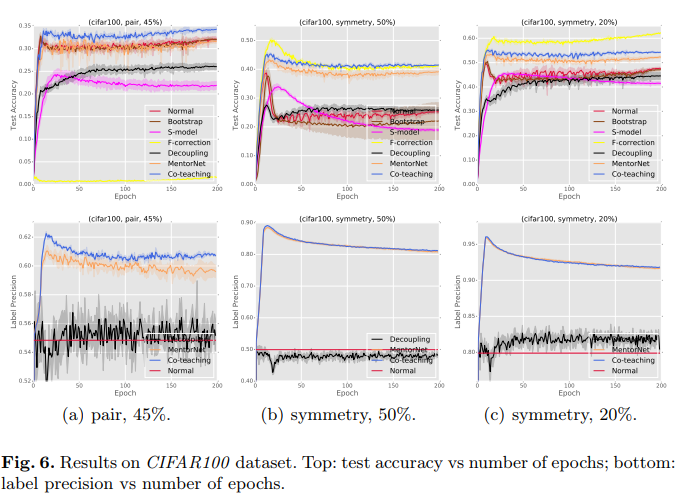
Choice of R(T) and [math]\displaystyle{ \tau }[/math]
There were some principles they followed when it came to choosing R(T) and [math]\displaystyle{ \tau }[/math]. R(T)=1, there was no instance needed at the beginning. They could safely update parameters in the early stage using the whole noise data since the deep neural networks would not memorize the noisy data. However, they need to drop more instances at the later stage. Because the model would eventually try to fit noisy data.
R(T)=1-[math]\displaystyle{ \tau }[/math] *min{[math]\displaystyle{ T^{c}/T_{k},1 }[/math]} with [math]\displaystyle{ \tau=\epsilon }[/math], where [math]\displaystyle{ \epsilon }[/math] is noise level. In this case, we consider c={0.5,1,2}. From Table 7, the test accuracy is stable.

For [math]\displaystyle{ \tau }[/math], we consider [math]\displaystyle{ \tau={0.5,0.75,1,1.25,1.5}\epsilon }[/math]. From Table 8, the performance can be improved with dropping more instances.

Conclusions
The main goal of the paper is to introduce the “Co-teaching” learning paradigm that uses two deep neural networks learning simultaneously to avoid noisy labels. Experiments are performed on several datasets such as MNIST, CIFAR-10, and CIFAR-100. The performance varied depending on the noise level in different scenarios. In the simulated ‘extreme noise’ scenarios, (pair-45% and symmetry-50%), the co-teaching methods outperforms baseline methods in terms of accuracy. This suggests that the co-teaching method is superior to the baseline methods in scenarios of extreme noise. The co-teaching method also performs competitively in the low-noise scenario (symmetry-20%).
Critique
Lack of Task Diversity
The datasets used in this experiment are all image classification tasks – these results may not generalize to other deep learning applications, such as classifications from data with lower or higher dimensionality.
Needs to be expanded to other weak supervisions (Mentioned in conclusion)
Adaptation of the co-teaching method to train under other weak supervision (e.g. positive and unlabeled data) could expand the applicability of the paradigm.
Lack of Theoretical Development (Mentioned in conclusion)
This paper lacks any theoretical guarantees for co-teaching. Proving that the results shown in this study are generalizable would bolster the findings significantly.
References
[1] B. Van Rooyen, A. Menon, and B. Williamson. Learning with symmetric label noise: The importance of being unhinged. In NIPS, 2015.
[2] S. Reed, H. Lee, D. Anguelov, C. Szegedy, D. Erhan, and A. Rabinovich. Training deep neural networks on noisy labels with bootstrapping. In ICLR, 2015.
[3] J. Goldberger and E. Ben-Reuven. Training deep neural-networks using a noise adaptation layer. In ICLR, 2017.
[4] G. Patrini, A. Rozza, A. Menon, R. Nock, and L. Qu. Making deep neural networks robust to label noise: A loss correction approach. In CVPR, 2017.
[5] E. Malach and S. Shalev-Shwartz. Decoupling" when to update" from" how to update". In NIPS, 2017.
[6] L. Jiang, Z. Zhou, T. Leung, L. Li, and L. Fei-Fei. Mentornet: Learning data-driven curriculum for very deep neural networks on corrupted labels. In ICML, 2018.